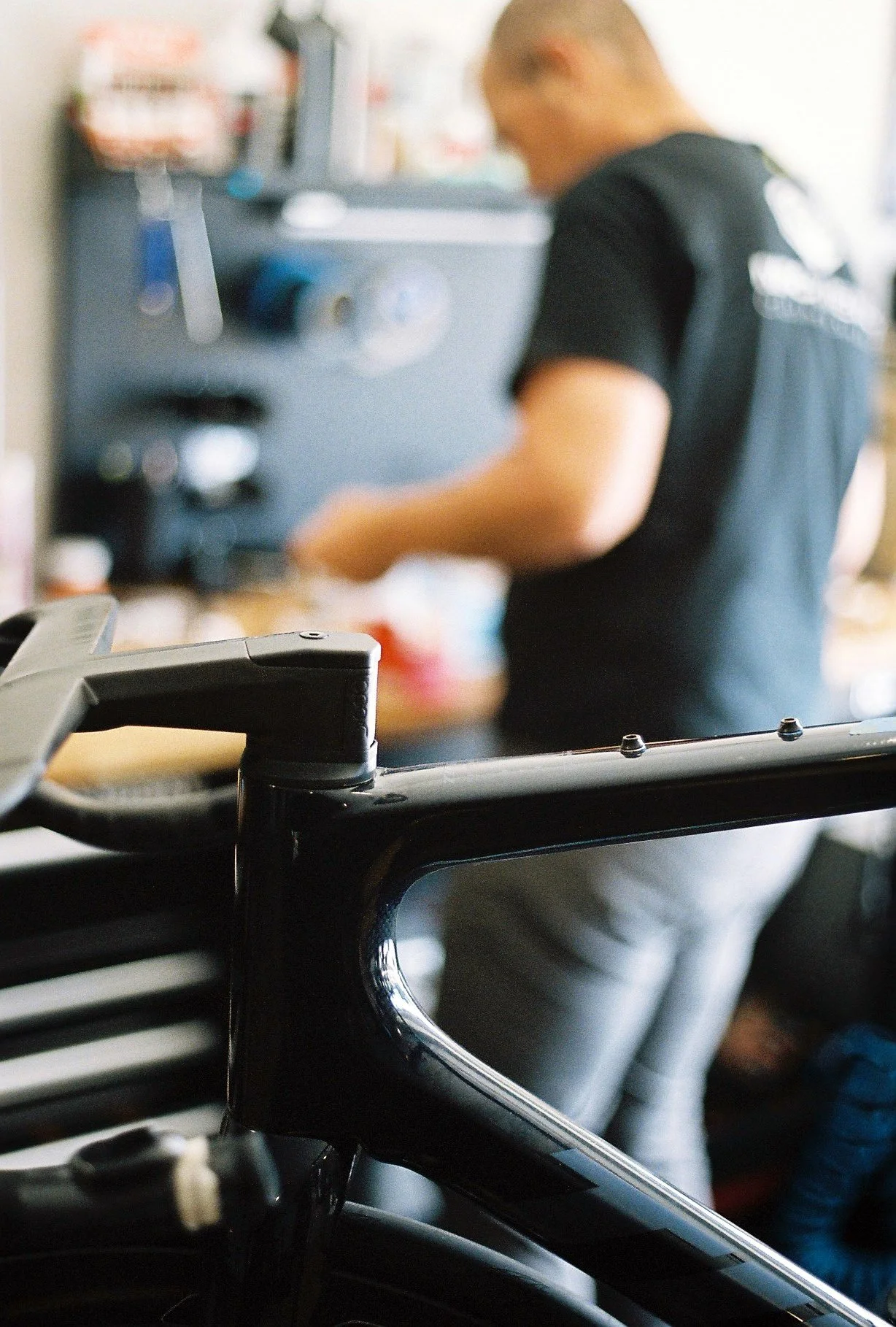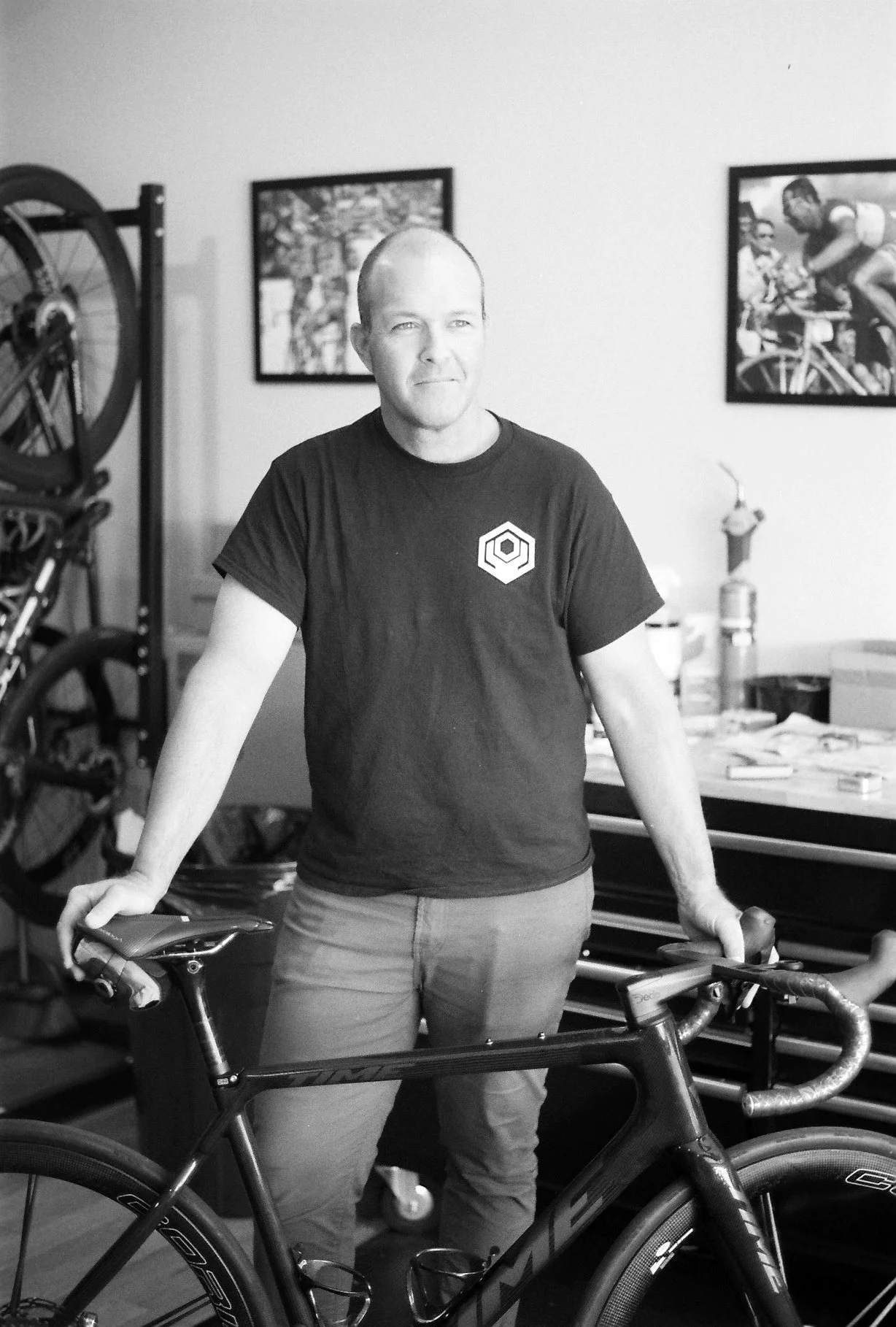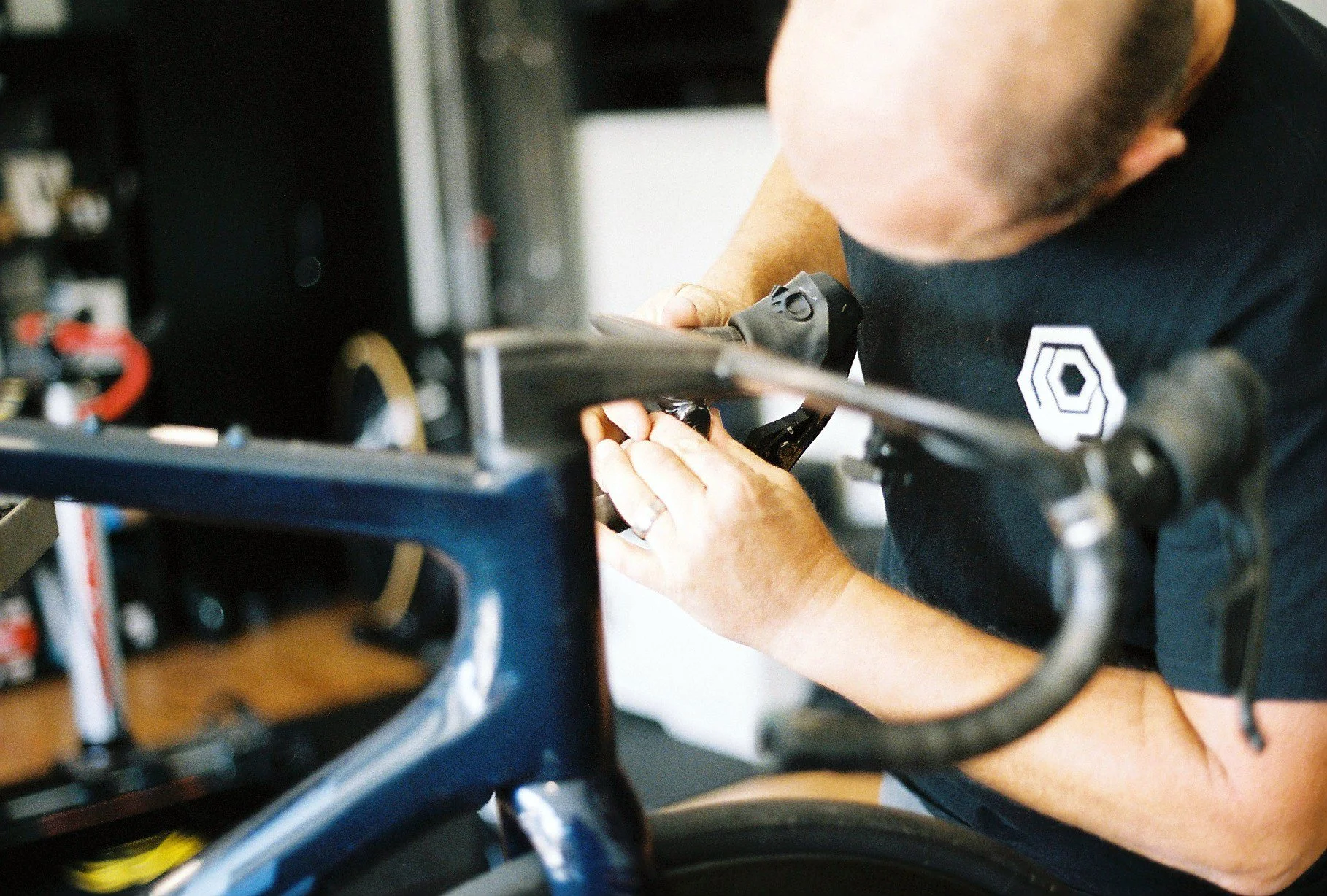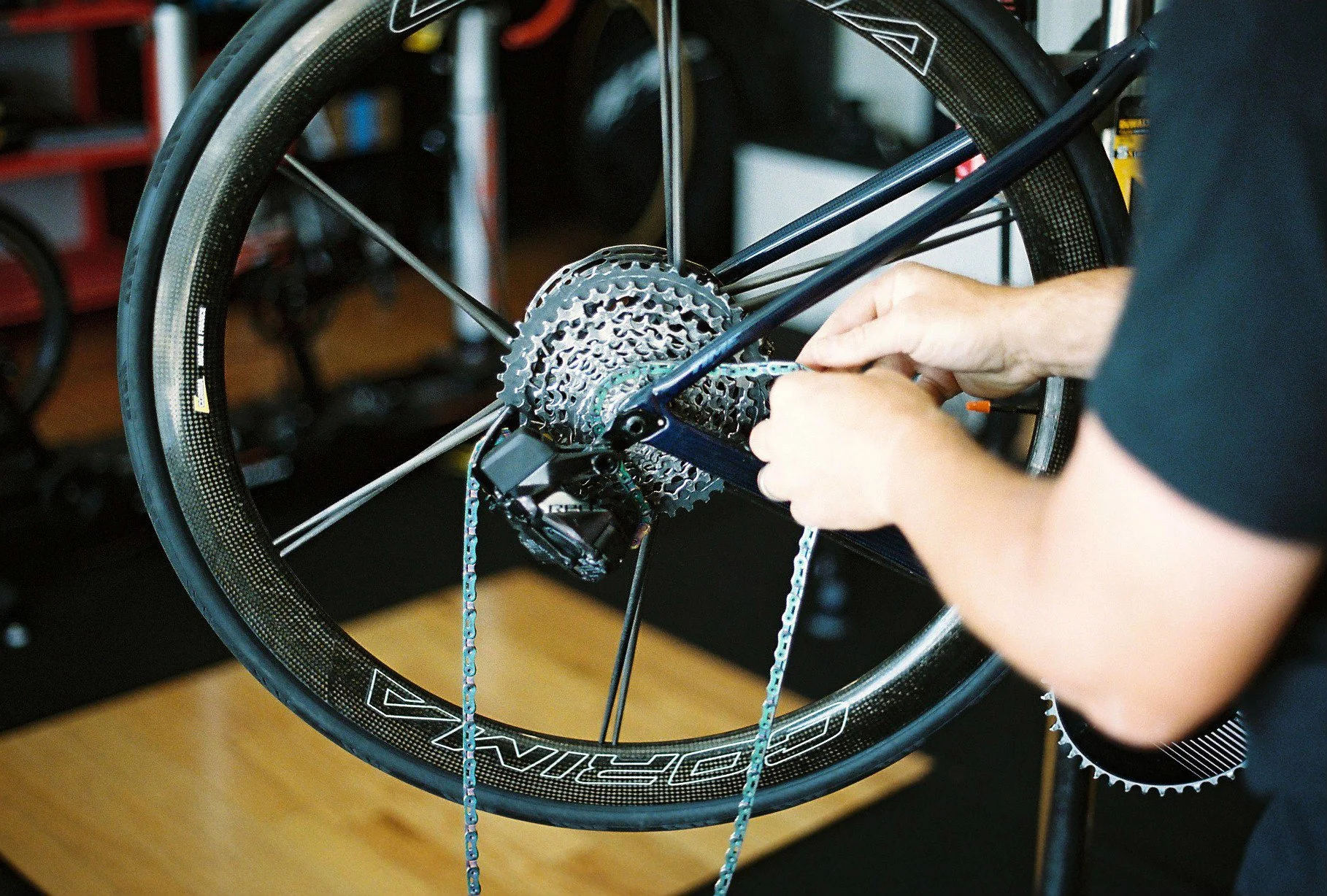Fitter | Mike Cahill
A conversation with Mike Cahill, Founder and Chief Executive Technician at MPCWrench Cycling Services
Let’s start with your background. How did you get into bike fit?
I’ve been in and around the bike industry my whole life—since I was about 13. But honestly, most of my personal and professional time has been outside of cycling, coaching in high-level alpine ski racing. Pretty much everything I’ve done has involved some type of gear-heavy, competitive environment.
On the bike side, I started out as a mechanic—working in shops, then doing team support in the mid-to-late ’90s in the mountain bike world. At that point, fit—as we think about it now—didn’t really exist. There was this thing called the Fit Kit. It was basically a wooden box full of tools that you’d use to take measurements off a person’s body. You’d plug those into their equation, and it would spit out a set of starting parameters for your fit. It was long-winded and probably needed a good computer behind it, but it was one of the earliest ways to distribute “good fit” knowledge at scale.
For me, fit kind of came in from both the mechanical side and the business side. There were new riders coming in who wanted to be comfortable or powerful on the bike, and then racers—myself included—trying to be more efficient. So fit became one of those things you had to know if you were working on bikes at a high level.
Back then, a lot of the rules came from what I call “Italian grandmother wisdom”—stuff like, “your handlebar should line up with your saddle,” or “your reach should be a certain length,” but no one was talking about drop. There wasn’t really a focus on individual biomechanics yet. Over time, as more science entered the sport, it became something I started specializing in more seriously.
You mentioned working in the car world too—does that tie into your work now?
Yeah, definitely. I’ve always loved fast cars, and I spent some time doing entry-level competition stuff when I was younger. But it became clear pretty fast that motorsports is a game of who has the biggest wallet—and I didn’t. So I stepped away, but I stayed close to that world. Some of my best friends work in high-level race car fabrication and racing, so I’ve always had access to it.
More recently, I worked professionally in that world again. And I think the connection to what I do now is that both require a really high level of care. Whether you’re servicing a Porsche GT3 RS or doing a Campy EPS build on a titanium frame, the mindset is the same. You have to be precise. You have to care about every detail. That carries over into how I approach fit.
What is MPCWrench?
It feels more like a studio than a shop. It’s a standalone service and fit space. I don’t sell bikes. I don’t carry inventory. If I need parts to do a job, I’ll source them, but I’m not stocking gear like a traditional shop. Honestly, I’ve been borrowing and cobbling together a lot through connections in the industry.
The core of the business is service and fit. I’ve built up a strong fit following over the last ten years or so. And what that allows me to do is focus entirely on the rider—their comfort, their goals, their bike—without having to worry about pushing product.
Do you think staying out of the sales side makes you more honest with clients?
I don’t know if it makes me more honest—because I’ve always been honest, sometimes to a fault—but it definitely removes the pressure. I don’t have to sell someone a part that isn’t right just to hit a number. On the flip side, it also means I don’t get the benefits of economies of scale. I’m not stocking deep inventory, so it’s less efficient. But the trade-off is worth it.
More than anything, what it gives me is freedom. The way most traditional bike shops are structured right now makes it really easy to fail. Not being locked into those requirements lets me control my own economy.
Okay, let’s talk about fit. Broadly, what is bike fit, and how do you approach it?
That’s one of those questions I get asked a lot, and it never has a single answer. Because the truth is, it depends on the rider. But in essence, bike fit is about setting up the bike so that the rider’s body can be as efficient as possible—efficient and comfortable—for what they’re trying to do.
That might mean preparing for a specific race, recovering from an injury, or just trying to make Sunday rides feel better. There are general principles that apply to everyone—alignment, stability, joint angles—but how you apply them varies completely depending on anatomy, history, and goals.
So, who needs a bike fit? Is it for everyone?
In theory, it can help anyone. But in practice, there are people who don’t need it at all. There are folks who can hop on a poorly fit bike and ride 50 miles and be just fine. And then there are others who go five miles and feel like they’ve been hit by a truck.
So I think fit plays a potential role for everyone, but how critical it is depends on the person. For me, the sign is discomfort. If someone says, “I don’t feel right on the bike,” whether it’s pain, handling issues, or even lack of performance—that’s the doorway. That’s when you come see me.
How does the actual fit process work in your studio?
It usually starts with a quick phone call. If it’s someone I’ve never worked with, I want to hear what they’re thinking—what brings them in—and I want to get a feel for how we connect. Honestly, a big part of the process is just seeing if it feels like a relationship that’ll work. I think of it kind of like a doctor-patient dynamic. If you don’t trust the person working on you, or if you’re not communicating well, it doesn’t matter how good the numbers are—the result won’t be right.
If that first call goes well, we schedule the session. Then, once we’re in the studio, the process really depends on what’s going on with the rider. If there’s a specific issue—like asymmetry, skeletal alignment problems, a chronic injury—then we might start with a physical assessment. I’m looking at structural stuff. Do they favor one side? Is there a leg length discrepancy? Do they have range-of-motion limitations? That kind of thing.
But sometimes, especially with newer riders or when the issue is less defined, we’ll just get them on their bike right away. I’ll have them warm up and pedal while we talk. Some of that interview probably started during the phone call—history on and off the bike, what bikes they’ve ridden, what hurts, what feels weird—but some of it happens live. I’m watching how their body moves while they’re riding. That tells me as much as the words do.
From there, I start with saddle position—both height and fore-aft. That’s the foundation. For saddle height, I want it as high as I can get it while still maintaining a stable ankle. The foot shouldn’t be collapsing or reaching or doing anything weird. The ankle should stay fixed—like a structural extension of the leg—and the power should come from the bigger joints above it: hips, knees, glutes. If the ankle’s moving too much, the saddle’s probably wrong.
Fore-aft is about balance. The further back the saddle is, the easier it is for the rider to stabilize their upper body weight without overloading the arms. Move it forward, and that stabilization gets harder. So it depends on their core strength, their experience, and what they’re trying to do on the bike. A lot of new riders aren’t used to supporting themselves from the core, so we might go more conservative. But racers often want to be more aggressive. Again—it’s situational.
Once the saddle is in a good place, I move to the cockpit. That’s reach and drop from the saddle to the bars. Same logic applies—it’s about balance, support, and efficient power transfer. I’ll also look closely at hood angle. That’s become a huge variable recently, especially with modern brake/shift levers and the rise of aero positioning. Vertical hood angle can impact wrist support, and rotating the hoods inward can create a more stable platform for riders who spend a lot of time in the drops or on the hoods in an aero tuck.
But really, none of this is a checklist. I don’t run people through a standardized sequence. There’s no “everybody gets this same set of measurements” approach. If I’m doing something a rider doesn’t need, I’m wasting their time and money. That’s not what I’m about. Every fit is tailored. Sometimes we spend 90 minutes dialing the cockpit. Sometimes we get the saddle right and everything else falls into place.
If the rider’s goal is comfort, the endpoint is when they get on the bike and stop feeling like they’re fighting it. If their hands feel light, if there’s no tension in the shoulders or neck, if the skeleton is supporting the weight instead of the muscles—that’s usually the sign that we’re there.
But if the rider’s there for performance—if they want to know whether they’re maximizing power—then we might go deeper. I’ll set their current fit on the fit bike, put them at a fixed cadence or wattage, and test what changes affect output. Do they lose power when we open the hip angle? Does shortening the crank reduce impingement but cost them torque? We isolate variables and look at the numbers. Sometimes a power gain comes at the cost of comfort—or vice versa—and we have to make a decision based on what matters most to that rider.
The goal is always the same: to make the bike work better for the body on top of it. But how we get there is different every time.
What does a successful fit feel like to a rider?
Ideally, it’s instant. That “aha” moment. They get on the bike and say, “Oh—this feels right.” That’s what I’m chasing every time. It’s not always dramatic, but more often than not, it is. People usually come in with a problem, and when that problem is solved, they feel it.
I had a guy in recently who said, “I just want you to look at my position.” I watched him ride for ten minutes and said, “There’s nothing to change. Whoever fit you did a perfect job. Go buy them a six-pack.” That’s the standard.
How does fit evolve over time—as riders age, train harder, or recover from injury?
Fit definitely changes. One of the biggest shifts I’ve seen recently is the widespread adoption of shorter cranks. Especially with aging riders or those with hip issues, reducing crank length has been a huge win. It helps reduce impingement and increases comfort and efficiency.
When you’re younger or more flexible, you might be trying to close down that hip angle and get every last watt. But as you get older, or start to lose mobility, you have to adjust. And that’s what fit is—adjusting to your body’s reality.
Are there differences between fitting men and women?
The process is the same, but the anatomy and structure are different. Center of gravity is one factor. Pelvic tilt, hip width, shoulder width—all of those can influence balance and weight distribution.
There was a big push a while back for women-specific bikes, but a lot of it was marketing—“pink it and shrink it.” I’ve seen plenty of women who ride better on bikes designed for men, and vice versa. You can’t make assumptions. You have to look at the rider in front of you.
Do you ever recommend gear or frame material changes?
Occasionally, yeah. There are small tweaks that can make a huge difference. Like some seatposts—Specialized had an old Roubaix post that wasn’t expensive or flashy, but it worked. Canyon makes one now that’s a pain to adjust, but it adds real compliance.
If someone has a super stiff bike and a sensitive back, sometimes the answer isn’t in the fit—it’s in the material.
What are a couple of things riders can do on their own to improve comfort?
For saddle height: put your heel on the pedal and rotate through the stroke. If you can just barely hold that pedal at the bottom, your saddle height is probably close. And for reach, when you’re stretched out on the hoods, your arms should be nearly straight with a soft elbow.
And yes, the old-school trick about the front hub being hidden behind the bars when you look down—it still works more often than not. Fitters will laugh at it, but I’ve seen it hold true thousands of times.
Favorite rider in the pro peloton? Who looks best on the bike?
Most of those guys look amazing—they’ve spent their whole lives on bikes. It’s rare to see bad form at that level. But I’ve got a soft spot for Alexander Kristoff. He’s older, he’s heavy by pro standards, and he’s still fighting for top finishes on the World Tour. As a mere mortal in the world of cycling, it's encouraging to see someone built like that performing.
Vanderpoel is great too—partly because I grew up watching his dad in cyclocross. Now I’m watching the next generation rip it up.
What’s your take on women’s cycling and how it’s evolved in the last few years?
It’s funny—you say “evolved,” and it definitely has in terms of visibility, but there’s always been strong women in the sport. I’ve had good friends racing at high levels going back decades. What’s changed recently, and what I think is really cool, is how social media has given more power and reach to female riders and influencers. You’re seeing stories and personalities that would’ve never made it into the old coverage model.
And the other thing is, because the women’s side of the sport is still growing—at least in terms of how it’s produced and broadcast—there’s something more real about it. There’s an honesty, or maybe just an openness, in how it’s shared. It tells a better story sometimes. It feels more relatable.
Last question: What’s your take on riding in Massachusetts?
I’ve lived in a few different parts of the country. I’ve traveled internationally for work. I’ve ridden my bike in a lot of places. And honestly, I still think the greater Boston area is one of the best places to ride on the planet.
People don’t always realize it, especially if they’re coming from somewhere with a more “famous” cycling scene. But what makes this area special is how old and weird the roads are. We don’t have a grid. Our road network predates cars—and in a lot of cases, even bikes. These were cart paths and walking trails, and they’ve evolved into thousands of miles of twisty, rolling, interconnected roads that snake through towns and woods and farmland.
From my front door, I could go out and ride five completely different century routes and barely overlap any roads. That’s not an exaggeration. It’s pretty incredible, once you know how to connect it all. And that kind of variety—that’s hard to find, even in places that are better known for cycling.
We don’t have big mountains, sure. If you’re chasing big alpine climbs, you’re not going to find them here. But we’ve got terrain. And if you want elevation, you can ride out to Wachusett and do intervals there. It’ll prepare you for just about anything short of the Alps.
Everywhere has its drawbacks. But the volume, the variety, and the rhythm of road riding we’ve got in this part of the world? I think it’s amazing.
Mike Cahill is the owner of MPCwrench Cycling Services, a fit and service studio just outside Boston, where he draws on more than thirty years of experience in the bike industry. Beyond the studio, he rides regularly and works as an alpine ski racing coach.
Conversation transcribed and condensed by Chessin Gertler | Photography by Chessin Gertler






